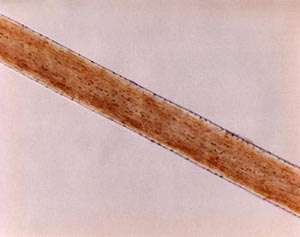Introduction:
All mammals are covered in hair at some point during their lives. Hair performs a variety of functions, including: keeping us warm, protecting our skin from the sun’s damaging rays, reducing friction, and keeping dust, dirt and sand out of our eyes, ears and noses. Hair is made of a protein called keratin and is not alive, but it does grow as keratin is deposited at the follicle base. Because hair is not alive, it does not decay quickly, making it useful evidence at a crime scene.
Materials:
- Compound microscope
- Microscope slides and cover slips
- Hair samples
- Clear nail polish
Instructions:
Begin by plucking a hair from your head. If your hair is attached to the follicle, center it on the slide. If not, you can prepare a dry mount of any part of the hair. View the slide under high power. If you can, compare your hair to that of family members, classmates, or even pets (either by preparing slides of their hair or viewing slides they have prepared themselves).
How do hair colors and textures change the appearance? For forensic technicians, this is one of the first steps in hair sample analysis. If hair from the crime scene matches the color, length and width or hairs from any involved people, they will continue the analysis. To make more accurate matches between hair samples, forensic techs analyze the pattern of the hair shaft.
To get a good look at the pattern on the hair shaft, you will need to make a cast. Spread a thin layer of clear nail polish on the center of a slide and allow it to set for 1-2 minutes. Lay the hair across the nail polish and let it dry. Once the polish is dry, remove the hair, add a coverslip and view under the microscope.
When possible, technicians will take analysis one step further. If the hair follicle remains, they can extract DNA from the cells and use this to get a much more accurate match because DNA is much more unique hair appearance.


